For this week’s post, I intended a piece of naval history, as this is a Substack focused primarily on the navy past and present, some political observations and historical stories, but sometimes other topics. This is one of those “other topics.” Next week, I’ll return to naval history, or policies, or more than likely some commentary on Star Trek to cleanse the line.
This week, however, is the story of faith and culture and education. It’s the story of immigration and emigration. It’s the story of politics and individual work. It’s the story of heritage, of ignorance, and rejection. It’s the story of one school and one town, but it could be any town in America, and likely is, with its consequences for the nation including national security
The gut-punch came on Friday as old classmate wrote a text to a bunch of us: “St. Dom’s is closing.”
The school named is St. Dominic Academy in its current incarnation, better known throughout most of its existence and original name of St. Dominic High School founded in 1941 in Lewiston Maine by a priest, Father Herve Drouin, O.P., and the Franco-American immigrants of Sts. Peter and Paul Parish, just a few years after the completion of the church which stands today as a basilica.
The Franco-Americans came to Lewiston to fill jobs in the massive textile mills on the Androscoggin River. They came to establish small businesses. They saw opportunities here that they couldn’t get in Quebec. The bought apartment buildings and houses. They, like the Irish immigrants before them, built Catholic Churches in their neighborhoods, close enough where they could walk to services. In a city of nearly 40,000, there would be what would be commonly referred to as the two Irish churches - St. Patrick’s and St. Joseph’s - and the three French churches - Holy Cross/St Croix, Holy Family/Ste Famille, and Sts. Peter & Paul, the massive church built in the middle of the Great Depression by those immigrants, my generation’s grandparents. It’s now down to one parish.
Fr. Drouin believed a school was needed and started a high school in 1941 for Catholic boys (St. Dom’s would eventually be co-ed a couple decades later.) He enlisted arguably the city’s most successful businessman and Catholic, F.X. Marcotte. One of his businesses, a furniture store, established at the turn of the last century, remains in operation. Marcotte donated $10,000 equivalent to $225,000 in 2025. As I recall my mother telling me, he was a major influence in the new immigrants straight off the railroad from Quebec finding them places to live and places to work back when there were French newspapers and organizations. Even now when I visit my parents’ grave, I drive by his mausoleum. It’s difficult to miss.
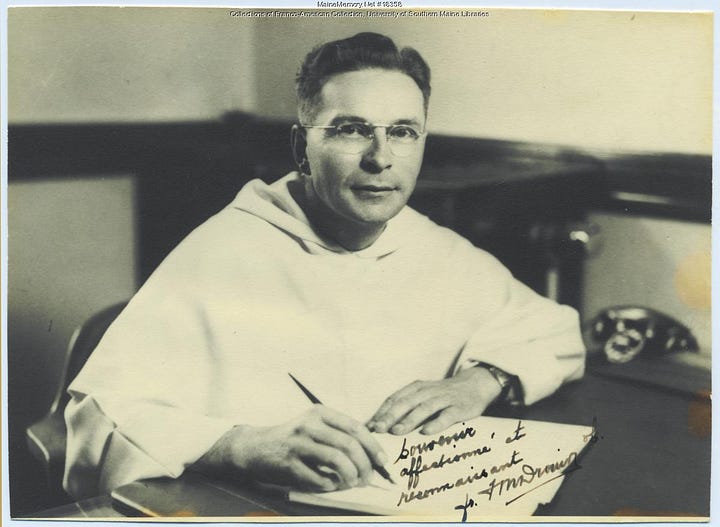
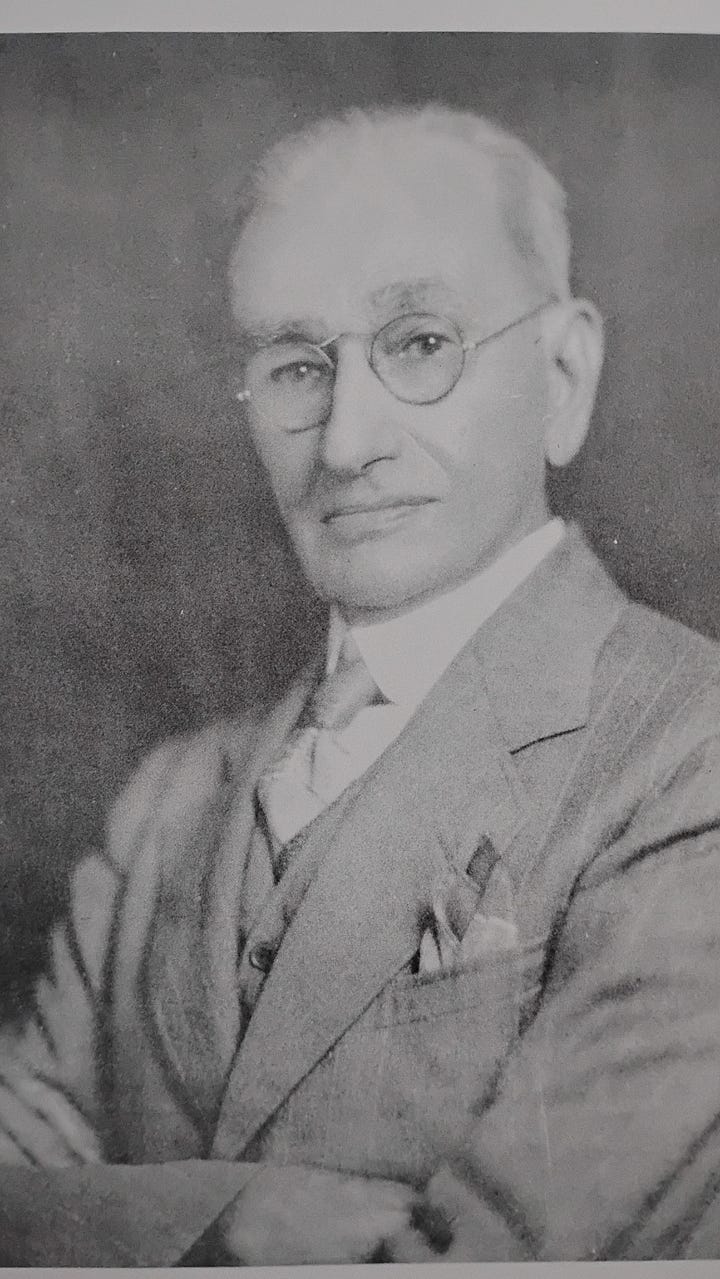
(Fr. Drouin, left, and F.X. Marcotte, right)
Drouin was a tour de force, even well into the 1980s when I last saw him. At a breakfast in 1982 with the two Democratic gubernatorial candidates, Drouin jokingly warned the incumbent to watch out for the other (my mother), as she was no longer the shy, blushing bride he knew in 1952 when he married my parents.
Catholics slowly started to build St. Dom’s. This was the first class:
Within four years, Drouin, the other priests of the Order of Preachers (Dominicans), and the Brothers of Sacred Heard (S.C.s for Sacre Coeur) built the student body:
Their courses included Latin, English, French, Typing, Religion, Civics, Algebra, and Mathematics. They entered in September 1941, just three months before the war started for the US. They were the Class of 1945, and as more than half of them were of age would be drafted before starting their senior year. My dad was one of those.
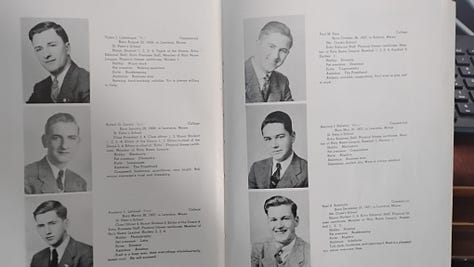
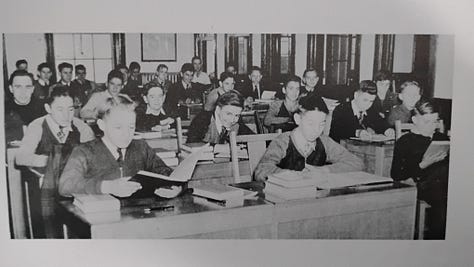

They were the St. Dom’s Saints, appropriate given that the public school had as its mascot the Blue Devil. It made hockey games pretty interesting to have the Saints and Devils compete. You always pick a side. Some sides are easier than others.
We’d hear from the Blue Devils at games or on the streets of Lewiston, “Hey Dommie” as an insult. It turns out it had a different origin story. The original yearbook explains that it was “DOMIE,” which stood for “Domino, Optimo, Maximo, Id” (“To God, the Best, the Greatest, that is…”
In all, there would be three different campuses in succession over its eight-decade history. The first school in Lewiston:

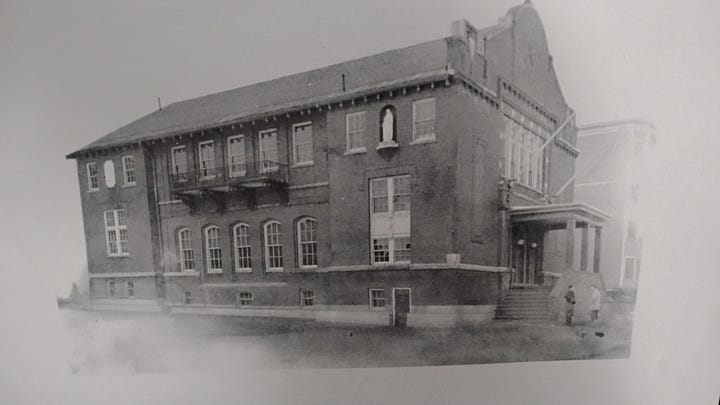
The second school a few streets away:

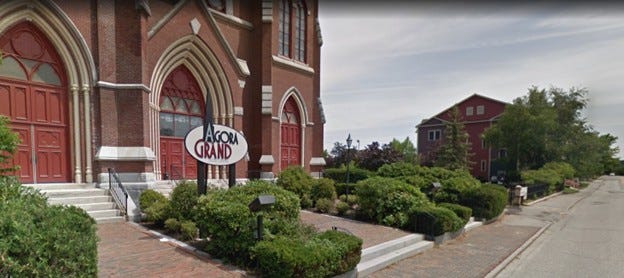
The third and current expansive campus in Auburn:
The first yearbook, the Echo, came out in 1945. Most of it was written in French, probably because my grandfather’s generation spoke and read little English. This is the rough translation of what Fr. Drouin wrote in it:
Future generations will read the names of our first graduates to whom the future will bestow the glorious title of founders. But what gives this directory an exceptional value is that it tells, for the first time, the story of the noble and daring adventure of a Franco-American Catholic parish which, in the aftermath of the construction of its majestic temple and still burdened with the weight of its debt, does not shrink from any sacrifice when the future of its children is at stake…Faith enlightened by love.
It only took two or three generations for that dream to end.
Less than 81 years from opening to closing. It certainly isn’t the only Catholic high school to have closed like Cardinal Dougherty in Philadelphia, at one time the largest Catholic high school not only in the United States but the world. St. Dom’s also won’t be the last to close.
For those readers who have a Navy background and alum from USNA imagine if the government closed the Academy. We might not think it possible given it is a government entity, but in the future the Navy will be smaller, much smaller, and rarely if ever larger. There may come a time where consolidation of schools with ROTC is necessary when fewer officers are needed. Imagine in one fell swoop the announcement comes, Gates 1, 3 & 8 are closed, and the facility is sold off by the government for high-end development.
This was the letter released by Bishop James Ruggieri of Maine on Friday:
After much prayer, consultation, and reflection, it is with a heavy heart that I share with you my decision to close the high school division of St. Dominic Academy (grades 9-12) at the conclusion of the current school year. This is a very difficult decision, and I am saddened by the impact it will have on the St. Dominic community. The closure of the high school is a significant loss to the present St. Dominic community, as well as to alumni/alumnae and the broader Lewiston-Auburn area.
The pre-K to grade 8 programs will continue. All these grades will reside at the Holy Cross campus in Lewiston for the 2025-2026 school year. School and diocesan leadership will collaborate during this period of change to build upon the foundation already established at the Lewiston campus. St. Dominic Academy in Lewiston will continue to provide a strong Catholic education for its students.
I realize that this announcement may be both shocking and deeply upsetting to you; however, based on a thorough analysis of enrollment data over the past eight years and financial data over the past five years, it is clear to me that the high school program is no longer financially sustainable.
I recognize and am grateful for the hard work that our current administration has invested in the school. I commend Mrs. Martin and her team for their courageous efforts. I am also aware of committed donors who continue to support the school. However, the present problems have some deep roots.
The school’s enrollment is 137 students, a third of what it was in the 1980s. It is, unfortunately, the trend. I say unfortunately for three reasons:
1. Generally - generally - Catholic schools afford a better education. I taught about 1,700 midshipmen at the Academy over 20 years (the last 11 teaching only one section a semester given my primary job as director of the museum) but is statistically sufficient to have allowed me to make many observations including this. There is a pyramid of groups based on how prepared they were for college. At the bottom of the pyramid generally (again, this is generally), were the public high school students. The next tier were sporadic public schools (upstate NY public schools performed well, for example). The second tier were private and Catholic high schoolers. The top? Home-schooled students.
2. The schools afforded the Catholic communities an option. It is part of their heritage. Nor was it isolated to Catholic students. Other families could send their children to them for the education.
I feel sorry for the freshmen, sophomores, and juniors who will not have more time to learn from committed teachers, continue to build friendships with their classmates, and make memories there until graduation. And I feel sorry for those teachers who will lose their jobs.
Upon first hearing of the closure, as an alum myself, I was, admittedly, angry. But it wasn’t at the letter. And upon reflection, it was to be predicted. I lived professionally as both a historian and an intelligence officer in the Navy, and I was trained to research, analyze and interpret trends, and consider possible consequences. This closure was, unfortunately, predictable and it goes to broader trends not only in the US but elsewhere.
The existence of Catholic schools is predicated on the existence of Catholics and the ability to send their children to Catholic schools.
Lewiston has followed what happened in Europe and then Quebec a generation ago. There are fewer Catholics attending masses and otherwise involved in their parish churches. Part of this is a result of the scandals that rocked the Church itself causing many to leave the church for Protestant churches or simply no churches. Part of it, in this case, is the out-migration of my generation. When the mills - the economic backbone of the city - closed in the 1980s and 1990s, adjacent businesses were also affected, as were opportunities. Some moved out of state to find employment; others moved out of the city to local towns where property was cheaper. As a result, the average age of attendees at Catholic services went up dramatically while at the same time overall numbers declined. The children were gone. There were fewer Catholic children, so schools closed. And with them the consolidation of various scouting troops and hockey teams when, for example, in the 1970s and 1980s there were so many parishes in the Twin Cities that each fielded a hockey team that competed against each other through the season.
Another factor was the cost per pupil which also increased. With fewer church goers, parishes had less of a financial base to support tuitions in those schools. With fewer Catholics entering religious life, the priests, brothers, and nuns who swore vows of poverty were replaced in the schools with lay teachers who understandably had to be paid (or paid more) to support themselves and their families.
Fewer Catholics, fewer funds, fewer educators. The Diocese might have done more at least in sustaining the school for longer but again, its priorities through Catholic Charities of Maine was elsewhere with its leadership and focus on bringing a largely Muslim population to the city two decades ago when the numbers began to suggest that the city would eventually face a massive population shift from one religion to another. I expect that in a few years some of the former churches will likely be purchased and repurposed as mosques. That’s not a judgment, just an observation and prediction from a demographic trend that is inevitable. This is also not unprecedented. It is a microcosm which is happening in Europe. For example, the Cathedral of Saint Sophia in Nicosia Cyprus is now the Selemiye Mosque, the Church of Saint-Eloi in Vierzon France was transformed into a mosque, Saint Ignatius in Amsterdam is now the Fatih Camii Mosque, there is now the Islamic Center Al Nour in Hamburg Germany that was a church, and, historically the most famous is Hagia Sophia in Istanbul.
A population’s replacement rate is 2.1 births per woman. Most of Europe falls below that rate. Italy has a 1.2 birth rate while France has the highest at 1.9. Muslim immigrants have a higher birth rate. Paris, arguably one of the most Catholic of countries, has more than 500,000 Muslims and Marseille some 250,000. Eventually demographics have an impact on a town or country in terms of religion and culture and eventually politics. There are far more Catholic funerals than baptisms in Lewiston, and it is why churches and schools have closed. Numbers matter. And eventually policies reflect the changing priorities of populations.
Fr. Drouin wrote the school song with a line that included the school’s colors: “The Black & White means ‘Fight, Fight, Fight!’” For a variety of reasons, either because of disagreement, apathy, emigration, or other priorities, we didn’t fight for the criteria that were needed to keep that school open. Again, that’s not a criticism but an observation. Based on what I’ve seen in recent months at masses, we might be the last generation that sees regular Catholic services in that city.
Sometimes I see this (and something I’ve written and spoken about extensively) as the same regarding why the US lost to China which became the world’s largest navy, something none of us could have envisioned. We all have our individual and collective reasons and priorities. We just need to recognize and prepare for those consequences.
St. Dom’s gave me much. The Brothers of the Sacred Heart made me question everything, including religious texts. The school prepared me for higher learning. The extracurricular activities exercised my mind. And of course, there were the people, for whom I am grateful. It is the people that make a place, but it’s good to have a place of continuity for shared memories. There’s a particular group of us who have been friends for 45 years since our first day freshman year, and are heading out together for a short vacation soon. I’m fortunate to be in such company; you know you’re in the company of friends when we don’t let each other get away with an BS and laughter is the primary form of communication. For that, and countless other memories, I will always be grateful to St. Dom’s.
As noted earlier, my dad was a member of that first class. He looked young as a freshman in 1941. He didn’t look much older when well before graduating he was drafted in March 1944 and found himself in the Battle of the Bulge.
I write this, coincidentally, on what would have been my father’s 99th birthday. Every day since his passing decades ago, I wish my dad was still here, but I think I know what he would have said to have learned of St. Dom’s closing, using the same uniquely Quebecois Catholic swear words I heard growing up. Today, for the first time since he passed nearly five decades ago, I’m almost relieved I don’t hear his voice and reaction.
Some may say of St. Dom’s “it was just a building” or a just school, or just an idea. It is - was - more than that. It was here when we needed it. I just wish we all could have had it longer.
Happy Birthday, dad. I wish we could have fought harder for our school.
Tabernak…





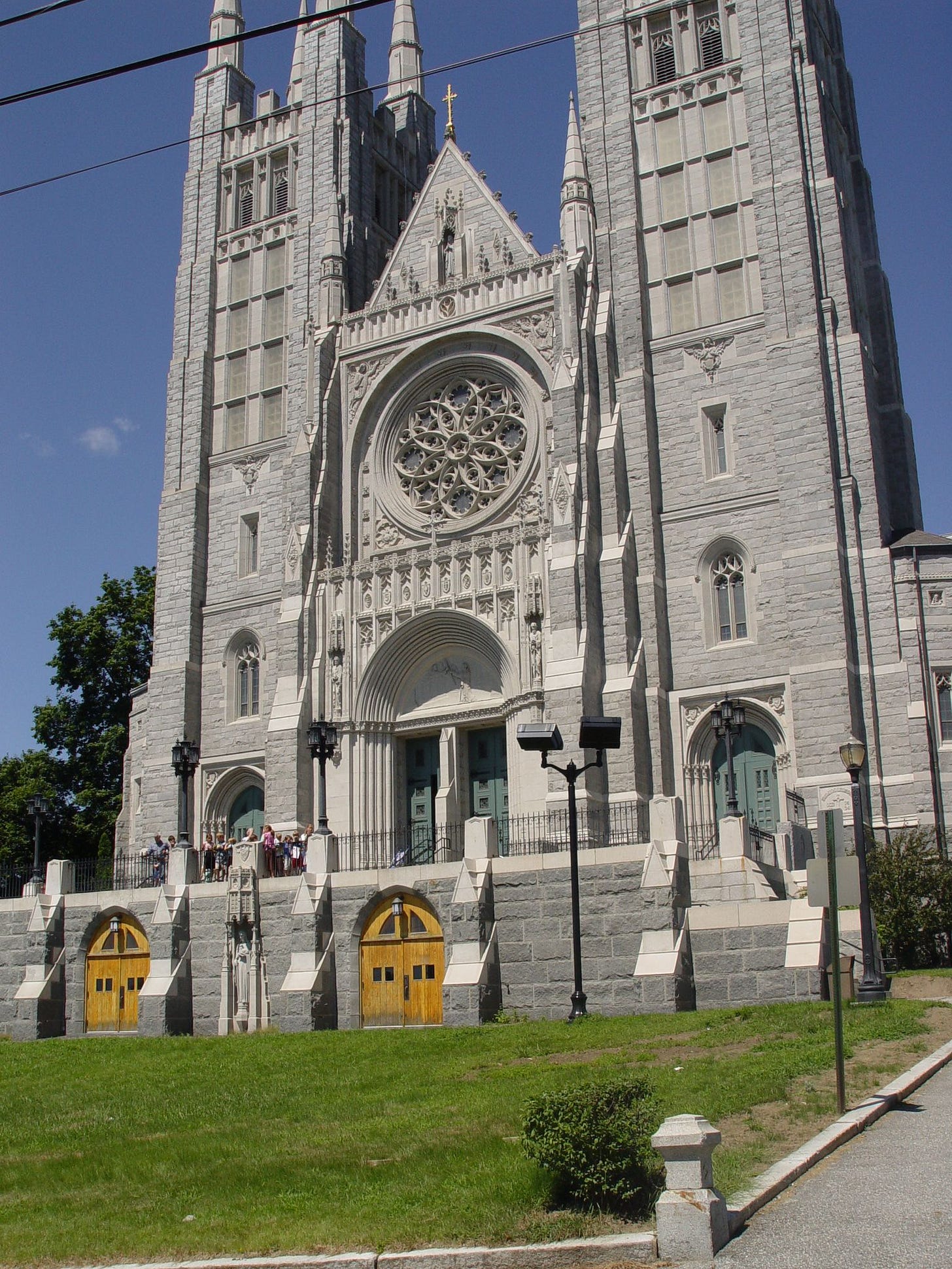




Sir,
Sorry to hear of the closing of your school. My family is from Newfoundland and unfortunately the decline of the Church is equally present there. Watching it in real-time throughout my yearly summer visits is both eerie and deeply saddening. As you’ve touched on here, outside of the spiritual ramifications, the change represents the aging and death of generations of people we hold dear.
I felt much the same way when the Diocese closed John Bapst in Bangor a few years after I graduated.